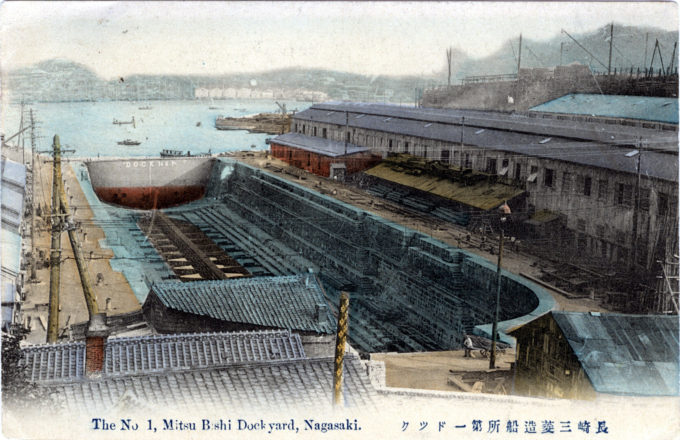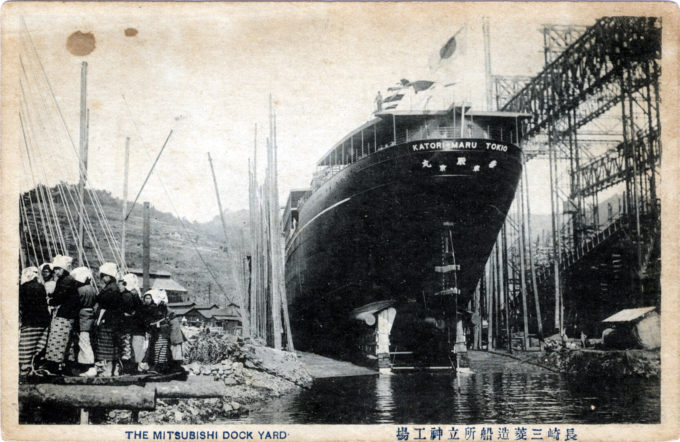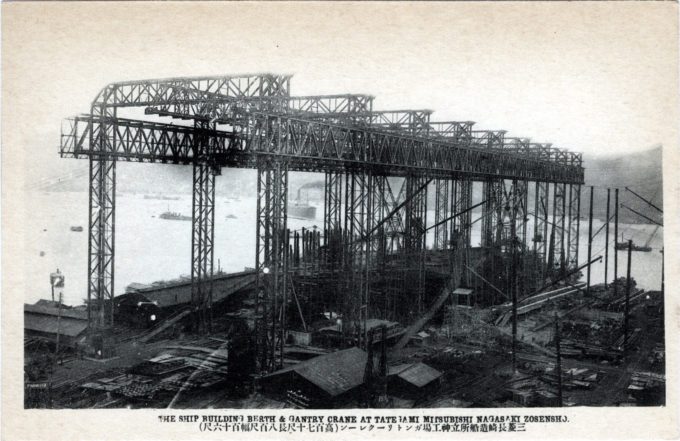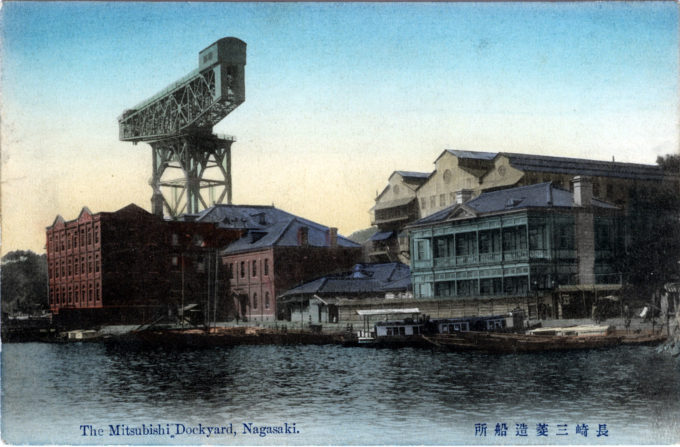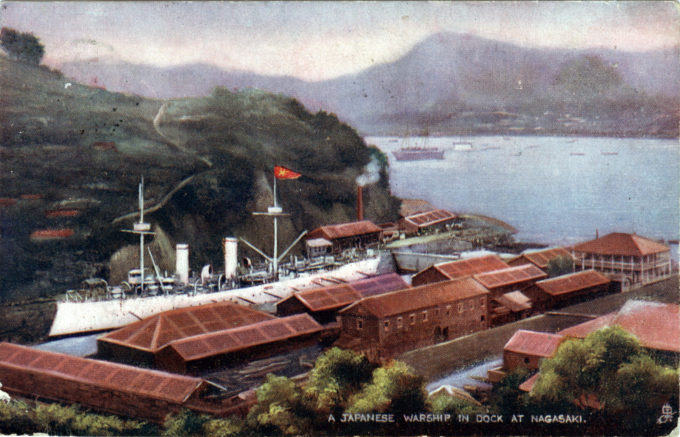
Mitsubishi shipyard, Nagasaki, c. 1905. In dry dock is the Akitsushima, a protected cruiser launched in 1892 which saw action in the First Sino-Japanese War (1894-1895) and the Russo-Japanese War (1904-1905).
See also:
Shinyo Maru, T.K.K. Line, c. 1930
“Across the harbor from Nagasaki are the Akuno-ura Engine Works, and the Mitsubishi Dockyards, the latter one of the largest of its kind in Nippon. It was established in 1856 by the Tokugawa shogunate, under the tutelage of Dutch engineers, but was transferred to the Mitsubishi Co. in 1877; since then its growth has been rapid.
“Battleships and ocean-going steamers of large tonnage are built here (ships like the Tenyo Maru and the Chiyo Maru of the Toyo Kisen Kaisha) and upward of 5000 men are employed. There are 3 dry-docks, salvage steamers, etc.”
– Terry’s Japanese Empire, by T. Philip Terry, 1914
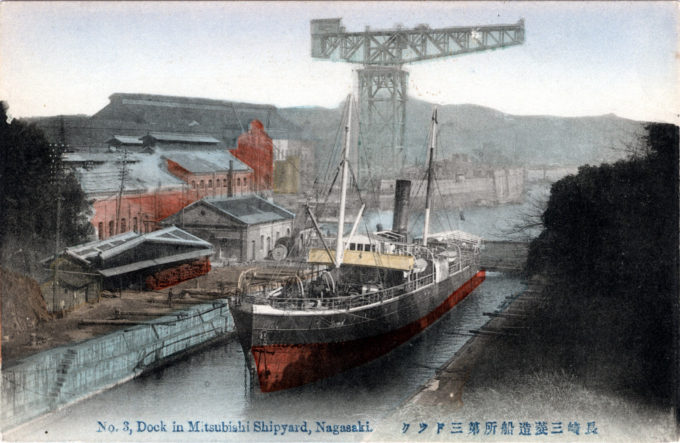
Dock No. 3, Mitsubishi Shipyard, Nagasaki, c. 1910. Dock No. 3 was constructed between 1901 and 1905 by utilizing the natural topography of the cove. The scale and design of the dock was indicative of Mitsubishi’s intention to build and repair some of world’s largest ships. It remains the only dry dock from the Meiji era still in operation today. Overhead is the Giant Cantilever Crane, the first electric-powered crane of its type in Japan, which began operations in 1909. It, too, remains in operation today.
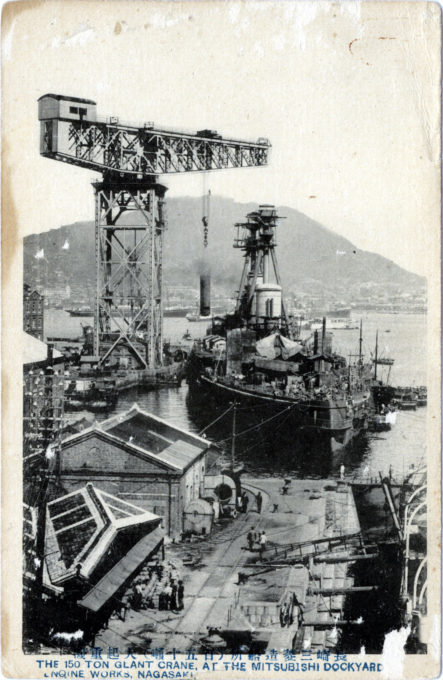
“The 150-ton giant crane,” Nagasaki Dockyard, c. 1920, the first electric-powered crane of its type in Japan. One of the largest battleships in the world, Musashi, was completed at the Nagasaki dockyard. Seen above is the battlecruiser Mutsu being outfitted prior to launch in 1921.
“In 1856, at the request of the Tokugawa Shogunate, a group of Dutch engineers began work on the Nagasaki Yotetsusho, a modern, Western-style foundry and shipyard near the Dutch settlement of Dejima, at Nagasaki. This was renamed Nagasaki Seitetsusho in 1860, and construction was completed in 1861. Following the Meiji Restoration of 1868, the shipyard was placed under control of the new Government of Meiji Japan. The first dry dock was completed in 1879.
“In 1884, Yataro Iwasaki, the founder of Mitsubishi, leased the Nagasaki Seitetsusho from the Japanese government, renaming it the Nagasaki Shipyard & Machinery Works and entering the shipbuilding business on a large scale. Iwasaki purchased the shipyards outright in 1887.
“The Nagasaki company was renamed Mitsubishi Shipbuilding & Engineering Company, Ltd. in 1917 and again renamed as Mitsubishi Heavy Industries in 1934. It became the largest private firm in Japan, active in the manufacture of ships, heavy machinery, airplanes and railroad cars.
“From its inception, the Mitsubishi Nagasaki shipyards were heavily involved in contracts for the Imperial Japanese Navy. One of two of the largest battleships in the world, Musashi, was completed and launched at Nagasaki in 1942.”
– Wikipedia
“[The founder of Mitsubishi] Iwasaki Yataro was born in the Tosa domain in 1834 into a family of former rural-samurai status. He was a diligent but mischievous student, and unlike many contemporary samurai, he appears to have made a conscious decision to study business and eschew activist political movements.
“The most important influence on Yataro was Yoshida Toyo, a Tosa official in charge of trade and industry, who was the domain’s leading proponent of Western learning. In the mid-1850s, during a period of forced retirement brought on by conservative opposition, Yoshida opened a private school, the Shorinjuku, which Yataro entered in his early twenties.
“The general thrust of Yataro’s later career clearly reflects Yoshida’s ideas. Yoshida was an advocate of shipping development and viewed economic competition as a fierce struggle among nations. Reportedly he warned his students that ‘the countries of the world are competing and expanding their territorial possessions and struggling to the death to build up their wealth.’ Japan, he went on, ‘must promote its industries, positively carry out trade with foreign countries, increase its wealth, and resist the countries of the world.'”
– Mitsubishi and the N.Y.K., 1870-1914: Business Strategy in the Japanese Shipping Industry, by William D. Wray, 1984


